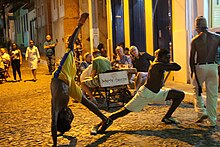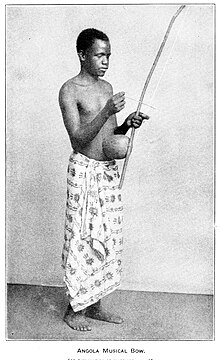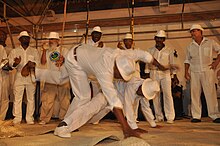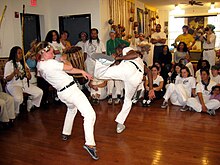|
Capoeira Angola
Capoeira de Angola (Angolan capoeira) or simply angola is the traditional style of capoeira, the Afro-Brazilian martial art. A newer style, based on the reform of capoeira Angola, is called regional. However, the term capoeira Angola is somewhat ambiguous and can mean two things:
Although mestre Pastinha strove to preserve the original art, he nevertheless introduced significant changes to capoeira practice. He forbid weapon and lethal moves, prescribed uniforms, moved training away from the street into the academia, and started to teach women.[1] But for mestre Pastinha, Capoeira Angola was, "above all, fighting and violent fighting".[2] The practice of capoeira Angola is to cultivate chants, music and culture in addition to the martial art, and to keep capoeira as close to its African roots as possible.[3] Angoleiros preserve oral traditions about capoeira's origins and maintain a connection with the ancestral art of engolo.[4] Capoeira Angola restored to mainstream capoeira the tradition of skillfully played capoeira music which the regional style had neglected.[5] NameThe name Capoeira Angola acknowledges the fact that Angolan slaves in Bahia were the ones who stood out the most in its practice.[6] HistoryOrigin of Angolan game
Capoeira first appeared among Africans in Brazil, during early colonial period. As with other Afro-Brazilian forms, oral communication is the basis of the transmission of knowledge and tradition.[9] According to the old capoeira mestres and tradition within the community, capoeira originates from Angola.[8][10] The very name of Capoeira de Angola (Angolan capoeira) emphasizes the origin of the discipline. The older names including jogo de Angola (Angolan game) or brincar de angola (playing angola),[11] also emphasize the Angolan origin of this discipline. Yet, some nineteenth-century authors rejected this claim because at that time a capoeira-like game was not known in Africa.[12] In the mid-twentieth century, the painter Neves e Sousa brought detailed drawings of the n'golo from Angola to Brazil, showing that there is an art similar to capoeira in Angola.[13] Ever since, many studies have supported the oral tradition, identifying engolo as an ancestral art and locating the Cunene region as its birthplace.[14][15][16] Traditional capoeira AngolaIn the 19th century, an extremely violent version of capoeira developed in Rio de Janeiro, associated with gangs, organized crime and murder. This street-fighting capoeira carioca used foot kicks, head butts, hand blows, knife fight and stick-fighting,[17] and was very different from the original Angolan art.[18] The Brazilian government completely banned the practice of capoeira throughout the country in 1890.[19]  In the plantations of Salvador capoeira was a form of amusement and activity. In Bahia's capoeira Angola, there was an inherent connection to religion, and almost all players were blacks or mestizos.[20] Among the Africans of Bahia, capoeira Angola was passed down as a kind of secret knowledge, which they did not share with others.[7] Muniz Sodré wrote:
Unlike Rio, capoeira in Bahia did not become a weapon of organized crime, although there were also capoeira neighborhood gangs,[22] and capoeiristas used blades as well.[23] Carybé, the artist of the early capoeira illustrations, wrote that the jogo de dentro ("inside game", with opponents very close to one another) was played with knives in the Capoeira Angola rodas.[24] Old Bahian capoeira was also known as vadiação (vagrancy).[25] Although illegal, capoeira continued to be played in Bahia. Mestre Bimba, who started learning capoeira in Salvador in 1912, remembers that in those times, "capoeira was practiced by horse-coach drivers, longshoremen, dock workers, and malandros".[26] The police used bullies as agent provocateurs in capoeira gatherings:
During the 1920s, there was capoeira school of Besouro Mangangá in the city of Santo Amaro.[27] During the 1920s, Mestre Noronha and other mestres founded the Centro de Capoeira Angola in Salvador, Bahia.[28] During the 1930s, one of the most famous player of the Angola style was Samuel Francisco Barreto de Souza, known as Mestre Querido de Deus.[21] First capoeira Angola center During the 1920s, Mestre Noronha, his brother Livino and many other capoeira Angola mestres, founded the Centro de Capoeira Angola at Ladeira de Pedra, Liberdade neighbourhood, in Salvador, Bahia.[28] Founding mestres were: Noronha, Livino, Maré, Amorzinho, Raimundo ABR, Percílio, Geraldo Chapeleiro, Juvenal Engraxate, Geraldo Pé de Abelha, Zehi, Feliciano Bigode de Seda, Bonome, Henrique Cara Queimada, Onça Preta, Cimento, Algemiro Grande Olho de Pombo longshoreman, Antonio Galindo, Antonio Boca de Porco stevedore, Candido Pequeno Argolinha de Ouro champion of Bahia, Lúcio Pequeno, Paquete do Cabula.[7] The colours of this centre were green and yellow, the colours of the Brazilian flag, and they were symbolized on the clothes worn by the disciples.[29] There were clear combat rules in their capoeira Angola center:
Reform and legalization of capoeiraSince the early 20th century, many teachers tried to bring capoeira back into the legal framework. After several attempts to codify the street version of capoeira from Rio, mestre Bimba from Salvador reformed Bahian capoeira and codified it into regional style. In early 1930s, Mestre Bimba developed systematic training method for capoeira, including kicks from other martial arts.[30] He called it Luta Regional Baiana (regional Bahian fight), because capoeira was still illegal.[31] In 1937, Bimba founded Centro de Cultura Física e Luta Regional, with permission from Salvador's Secretary of Education. His work was very well received, and he taught capoeira to the cultural elite of the city.[31] By 1940, capoeira finally lost its criminal connotation and was legalized. Pastinha's capoeira Angola center
In response to a series of reforms, which changed capoeira considerably, Mestre Pastinha decided to preserve and popularize the traditional African style known as capoeira de Angola,[33][34] from which the reformers distanced themselves. In 1941, old capoeira Angola mestres who ran the first capoeira Angola center recognized a capable person in Pastinha and entrusted him with managing the center in Liberdade.[28] That year, he legally registered Centro Esportivo de Capoeira Angola (CECA), in the Salvador neighborhood of Pelourinho, which attracted many traditional capoeiristas. He made his mission to clearly separate capoeira Angola from the violence.[35] Pastinha adopted the colors of his favorite soccer club, Ypiranga, yellow and black, which became the hallmarks of the Angola style he taught.[36] Despite their significant differences, both mestres introduced major innovations – they moved training and rodas away from the street, instituted the academia, prescribed uniforms, started to teach women and presented capoeira to a broader audiences. Academy periodPastinha gathered a number of excellent players around him, not only because of his playing style but also his personal qualities.[37] However, many capoeira Angola mestres including Waldemar, Cobrinha Verde and Gato Preto did not become part of Pastinha's school, and the art continued to live outside the academy as well.[11][38] Mestre Waldemar regularly held his rodas in the neighborhood of Liberdade, during the 1940s and 1950s. The traditional method of learning capoeira Angola, which persisted into the 1960s and beyond, relied on intuitive learning and observation. There was no structured training centered on repetitious movements.[39] The angoleiros' efforts to distinguish capoeira Angola thwarted the attempts of the authorities in the 1970s to uniformize capoeira as the Brazilians' national sport.[40] In parallel, capoeira Angola began to lose popularity, and by the 1970s many angoleiros switched to Regional popularized by Grupo Senzala. Some of the old Angola mestres had retired and they no longer taught due to the lack of disciples.[41] But since the 1980s mainly the opposite seems to occur. After observing distinct angoleiro players from Bahia, regional players such as Marrom from Senzala in Rio de Janeiro, Deraldo in Boston and China in Barcelona have decided to become angoleiros.[42] Since 1985, capoeira Angola experienced a revival with an influx of new students. Maybe due to increase in students, or perhaps to the success of the Senzala method, the Angola teachers adopted the new teaching method, including warm-ups, structured sequences of movements, uniform execution of kicks, and more.[39] As a result, contemporary angoleiros from a particular academy tend to exhibit a uniform style of play.[39] Around 2010, mestre Cobra Mansa and few other capoeira Angola players went on a research trip to Angola, searching for the roots of the game. There they found players of the nearly extinct engolo game and played joint capoeira-engolo games with them.[4] Music Traditionally, capoeira in Bahia was exclusively accompanied by a large Bantu drum, which had been targeted by police repression in the 19th century.[43] In the early 20th century, the most significant musical change was the shift from the drum to the berimbau, becoming the primary instrument in capoeira.[44][45] The transition may have been influenced not only by musical preferences but also by the berimbau's dual role as a weapon.[46] Before the mid-20th century, various combinations of instruments were used in capoeira Angola. Muniz Sodré wrote that in Santo Amaro, capoeira music was played to the sound of a small guitar.[47] Mestre Pastinha formalized the instruments of capoeira Angola orchestra in his academy. He experimented with various instruments, occasionally incorporating guitars (viola de corda) and even introducing Spanish castanets into the roda.[36] The current standardized formation of three berimbaus, two pandeiros, one agogô, one reco-reco, and one atabaque likely did not become established until the 1960s.[36] Although, in mestre Waldemar's rodas, they did not have atabaque, a big drum.[48] Today, typical bateria formation in capoeira Angola is three berimbaus, two pandeiros, one atabaque, one agogô and one ganzuá.[49] The rhythms Angola and São Bento Grande were just two among many others used in traditional capoeira.[50] Pastinha based his style on the slower Angola rhythm, while Mestre Bimba preferred the faster São Bento Grande, although both used a wide range of toques.[50] Today, capoeira Angola music is generally slow.[25] TechniquesCapoeira Angola actually has a small number of moves compared to some other martial arts. According to mestre Pastinha, the principal kicks of capoeira Angola are: [51] In Capoeira Angola, there are a limited number of kicks, but each blow has numerous modalities depending on where it is applied.[52] Every strike has variations, so what at first glance seems simple becomes complex.[53] This basic techniques allows a proper jogo de dentro (inner game) to develop.[54] Characteristics Capoeira Angola emphasizes slower, ground-level game. The games in capoeira Angola last long, sometimes over ten minutes, enabling a more extended dialogue among participants.[55] Capoeira Angola rodas can last anywhere from two to five hours.[56] Some rodas in Salvador are known to be dangerous, while others are considered to be mild.[56] Practically, there is no age limit for entering a Capoeira Angola academy.[57] In Pastinha's academy, there was a very high number of people over 60 years of age who have practiced capoeira, with impressive joint agility and flexibility.[57] This approach shares similarities with African dances, which encourage individuals to dance according to their abilities. In Africa, dance is accessible to everyone.[58] Capoeira Angola is characterized by being strategic, with sneaking movements, it values the traditions of malícia, malandragem and unpredictability of the original capoeira.[3] The anthropologist Alejandro Frigerio defines capoeira Angola as art, versus capoeira Regional as sport. He emphasizes the following characteristics of contemporary capoeira Angola, namely: cunning, complementation (of the two players" movements), a low game, the absence of violence, beautiful movements (according to a "black aesthetic"), slow music and the importance of ritual and theatricality.[25] Despite its playful appearance, capoeira Angola is always a potentially violent art form.[56] Old mestres teach that capoeira Angola is "the art of fighting with a smile", but they also emphasize the importance of being prepared to defend oneself.[56] Capoeira Angola is inextricably linked to African religious and ideological beliefs. Many capoeira Angola mestres in Bahia had a connection to the candomblé religion.[59] ClothingUnlike many other capoeira groups that play barefoot, angoleiros always train with shoes. When it comes to the color of the uniforms, there is a lack of uniformity within the style. Although mestre Pastinha at his academy required students to wear yellow and black jerseys, some of his successors have adopted white only uniforms within their schools.[42] Angoleiro identityThere exists a significant discrepancy between how some capoeira players define themselves and how others categorize them. Determining who qualifies as an angoleiro, for example, is far from straightforward. Those who were students of Pastinha and later became mestres are widely acknowledged as the central figures in the Angola style. This recognition also extends to disciples of other renowned mestres like Cobrinha Verde or Waldemar.[60] However, beyond this core group, many other capoeiristas claims to be angoleiros as well. Their assertion faces challenges from dedicated angoleiros on two fronts: lineage and technique. Capoeiristas who have practiced different styles for an extended period and then decide to switch to Angola are often viewed with disapproval and labeled as regional.[60] Interpretations
Assunção points out that because capoeira Angola has evolved in contrast to Regional, there is a tendency to "purify" it of all the elements perceived as Regional, even if they come from old Angola.[25] It seems that capoeira Angola has evolved into a significantly positive reference in mainstream capoeira. It's viewed as synonymous with the roots of capoeira. So, angoleiro mestres are frequently invited to Regional events, yet the reverse rarely happens because Regional mestres are not considered to have competence in Angola circles.[50] So, while Angola is considered the mother of Regional, Regional has become a kind of devil for many angoleiros, who dislike "aggressive" games and "violence".[42] Notable mestresSee alsoWikimedia Commons has media related to Capoeira Angola. Literature
References
|
||||||||||||||||||||||||||||||
